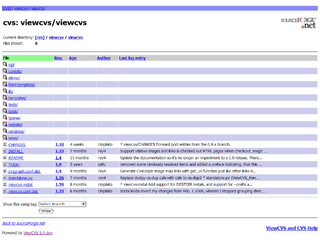Revision Control System(RCS) is an early version control system (VCS). It can be thought of as a set of UNIX commands that allow multiple users to develop and maintain program code or documents. With RCS, users can make their own revisions of a document, commit changes, and merge them. RCS was originally developed for programs but is also useful for text documents or configuration files that are frequently revised.

Apache Subversion is a software versioning and revision control system distributed as open source under the Apache License. Software developers use Subversion to maintain current and historical versions of files such as source code, web pages, and documentation. Its goal is to be a mostly compatible successor to the widely used Concurrent Versions System (CVS).

Git is a distributed version-control system for tracking changes in source code during software development. It is designed for coordinating work among programmers, but it can be used to track changes in any set of files. Its goals include speed, data integrity, and support for distributed, non-linear workflows.
In software development, distributed version control is a form of version control where the complete codebase - including its full history - is mirrored on every developer's computer. This allows branching and merging to be managed automatically, increases speeds of most operations, improves the ability to work offline, and does not rely on a single location for backups.

ViewVC is an open-source tool for viewing the contents of CVS and SVN repositories using a web browser. It allows looking at specific revisions of files as well as side-by-side diffs of different revisions. It is written in Python and the view parameters can be modified directly in a URL using a REST style interface.
Sun WorkShop TeamWare is a distributed source code revision control system made by Sun Microsystems. Last available as part of the Forte Developer 6 update 2 product, TeamWare is no longer being offered for sale, and is not part of the Sun Studio product.
In software development, a codebase refers to a whole collection of source code that is used to build a particular software system, application, or software component. Typically, a codebase includes only human-written source code files; thus, a codebase usually does not include source code files generated by tools or binary library files, as they can be built from the human-written source code. However, it generally does include configuration and property files, as they are the data necessary for the build.
The CVSNT Versioning System implements a version control system: it keeps track of all changes in a set of files, typically the implementation of a software project, and allows several developers to collaborate. It is compatible with and originally based on Concurrent Versions System (CVS), which has become popular in the open-source world.
The Distributed Concurrent Versions System (DCVS) is a distributed revision control system that enables software developers working on locally distributed sites to efficiently collaborate on a software project. DCVS is based on the well known version control system Concurrent Versions System. The code is freely distributable under the GNU and BSD style licenses.
Cogito is a revision control system layered on top of Git. It is historically the first Git frontend, which appeared in April 2005, just days after Git itself. While Git was initially meant just as the low-level interface, Cogito started with the stated goal of becoming a user-friendly front-end.

TortoiseSVN is a Subversion client, implemented as a Microsoft Windows shell extension, that helps programmers manage different versions of the source code for their programs. It is free software released under the GNU General Public License.
The following is a comparison of version-control software. The following tables include general and technical information on notable version control and software configuration management (SCM) software. For SCM software not suitable for source code, see Comparison of open-source configuration-management software.
Google Code Search was a free beta product from Google which debuted in Google Labs on October 5, 2006, allowing web users to search for open-source code on the Internet. Features included the ability to search using operators, namely lang:, package:, license: and file:.
Apache Gump is an open source continuous integration system, which aims to build and test all the open source Java projects, every night. Its aim is to make sure that all the projects are compatible, at both the API level and in terms of functionality matching specifications. It is hosted at gump.apache.org, and runs every night on the official Sun JVM.
Fisheye is a revision-control browser and search engine owned by Atlassian, Inc. Although Fisheye is a commercial product, it is freely available to open source projects and non-profit institutions. In addition to the advanced search and diff capabilities, it provides:
SVNKit is an open-source, pure Java software library for working with the Subversion version control system. It is free to use on opensource projects but requires that you buy a commercial license to use to develop with proprietary software. It implements virtually all Subversion features and provides API to work with Subversion working copies, access and manipulate Subversion repositories.

Meld is the visual diff and merge tool of GNOME, targeted at developers. It allows users to compare two or three files or directories visually, color-coding the different lines.
In revision control systems, a repository is a data structure which stores metadata for a set of files or directory structure. Depending on whether the version control system in use is distributed or centralized, the whole set of information in the repository may be duplicated on every user's system or may be maintained on a single server. Some of the metadata that a repository contains includes, among other things:





